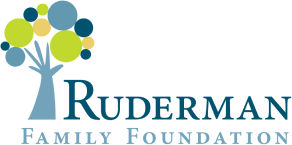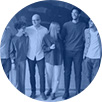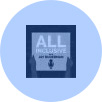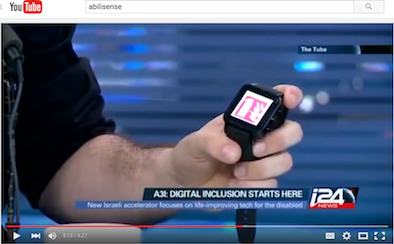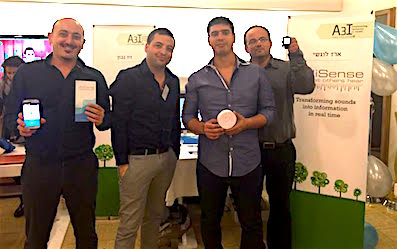
Meet the technology allowing people with hearing impairment to see sounds
[:en]A3i – Accelerating Inclusion in Israel – is the first accelerator program anywhere dedicated to ventures that improve the quality of life for people with disabilities. A3i nurtures innovative high-tech entrepreneurs, offering intense training, mentorship, one-on-one consulting, and the opportunity to take an active part in the innovative community of entrepreneurs in Israel. The accelerator was an initiative of the Ruderman Family Foundation, in partnership with PresenTense, Beit Issie Shapiro, and The Jewish Federation of Greater Los Angeles.
AbiliSense is developing innovative technology that visually and immediately alerts users to specific sounds, using their wearable, mobile or desktop devices. Erez Lugashi, CEO of AbiliSense, is one of the entrepreneurs chosen for the 2015 cohort. He recently took time to discuss the product and some lessons learned.
RFF: The video demonstrates how the personal device helps people with hearing impairment. How will the business application work?
Erez Lugashi: We’re going to install a sensor that constantly listens to background noises. We’ll teach this sensor all the sounds around the company, such as the smoke alarms. We’ll then create a signature for that unique sound, and install it onto the sensor. We’ll also record the other sounds, and the end client – whoever visits or works in that establishment can access a software applications that generates electronic alerts whenever those sounds are heard.
In one of the pilot companies, there aren’t many individuals with hearing impairment. But there are many high-tech professionals working in cubicles, in close quarters, and so to avoid interruptions and distractions they often wear headphones in order to work. In this situation, you become disconnected from the environment, and if there’s any outside sound like a smoke alarm, you won’t hear it. With AbiliSense, you’ll get a notification to your PC screen, laptop or wearable, or the application on your mobile phone.
RFF: So the market becomes much wider than simply people with hearing impairment – it’s a high-tech solution to a high-tech problem.
EL: Yes, it can be used by people with no disabilities. If you’re working with headphones, it will give you an option to still receive critical notifications, or even if someone is buzzing at the door, across a variety of platforms. We can also deliver the information by way of the lighting. If its’ a smart light, and someone is knocking on your door or using the intercom, the light will flash a different color depending on the notification.
RFF: Are you developing software that allows the technology to learn new sounds on its own?
EL: Our approach is to do this by two ways. The first is that you train the device with your own sounds, and the second is that we regularly provide the signatures, and it works like an anti-virus; even if you haven’t trained it yourself, the system will still recognize the sound. We’ve developed an algorithm so that afterward, you can add this new sound to your customized home sounds.
RFF: To what extent are you able to use or modify existing technology and software products, and how much do you have to create brand-new technology?
EL: Audio-recognition technology is not unprecedented. What we’re doing is using our own algorithm to identify these sounds, which are less than three seconds in duration. Within this short timeframe, we can identify the signature – which is very fast in this field. Most people know about sound algorithms through Shazam, the music recognition app. Wjhen we try to explain to technology-oriented people what it is we’re doing, we tell them we’re the Shazam of hearing impairment, and they understand.
RFF: This seems like a very marketable product. Would you have been able to get off the ground without the A3i support?
EL: I don’t think this product would be something we could develop without A3i. The accelerator brought this from an idea in my head, into reality. A3i deserves a lot of credit, especially the Ruderman Family Foundation, Beit Issie Shapiro, PresenTense, the Los Angeles Federation. And thanks to A3i, I also have a mentor, Shuki Barabash, who has guided us in so many ways.
RFF: What advice do you have for new start-ups that are seeking A3i support?
EL: They should be open-minded, think about and focus on the impact they’re going to have. Of course, before it all, write up just a small business plan, to assess whether there’s a market and a need. In the end, start-ups need money, and it’s much harder to secure funding for a social start-up — the investor needs to understand how it’s going to make money. So, look at the market, think of new angles for how your technology can open the market.
My market, for hearing impairment, is 360 million people around the world, and it’s not that big. To an investor, it’s not so impressive; when you clean it up, it’s limited to the developed countries, where the price is profitable and there’s a technology infrastructure. You need to check the market, assess the competition, figure out where you can get an advantage. Otherwise, you won’t win out. Don’t just say, “I have no competitors” – it’s unprofessional, and the investor will understand that you didn’t do your homework.
RFF: Give us an idea of your background, and what you were doing before AbiliSense.
EL: For about ten years, I was in the information security sector, working for companies in data communication, information security systems, including work in Africa for an American company. After that, I moved back to Israel and tried to launch two start-ups – they failed at the start, becaues the other founders weren’t ready to invest money. Then I opened my first business, with a friend, in the information security market, and then another company in the same sector.
In autumn 2014, there was a war in Israel. Once, when I heard the “red color” air-raid siren, I was running to my home shelter, and that’s when I first conceived of what eventually became AbiliSense – and I applied to the A3i Accelerator. I started working on this full-time only last spring, after getting accepted into A3i. Now, we are an Ltd. company, and will soon be running a couple of B2B pilots, to make different types of businesses acessible. I’ve added three employees – Elad Amran, the product manager; Dimitry Feldsherovitch, who develops the algorithms; and Einat Ben Dov, based in the United States, who’s doing business research.
When I’m asked about my exit strategy, I always give the same answer: That one person will come to me and say, “Because of your product, I saved my child—I have a baby and I was sleeping, I got a notification in time, and now he’s alive because of your product.” This is our exit strategy.[:he]
A3i – Accelerating Inclusion in Israel – is the first accelerator program anywhere dedicated to ventures that improve the quality of life for people with disabilities. A3i nurtures innovative high-tech entrepreneurs, offering intense training, mentorship, one-on-one consulting, and the opportunity to take an active part in the innovative community of entrepreneurs in Israel. The accelerator was an initiative of the Ruderman Family Foundation, in partnership with PresenTense, Beit Issie Shapiro, and The Jewish Federation of Greater Los Angeles.
AbiliSense is developing innovative technology that visually and immediately alerts users to specific sounds, using their wearable, mobile or desktop devices. Erez Lugashi, CEO of AbiliSense, is one of the entrepreneurs chosen for the 2015 cohort. He recently took time to discuss the product and some lessons learned.
RFF: The video demonstrates how the personal device helps people with hearing impairment. How will the business application work?
Erez Lugashi: We’re going to install a sensor that constantly listens to background noises. We’ll teach this sensor all the sounds around the company, such as the smoke alarms. We’ll then create a signature for that unique sound, and install it onto the sensor. We’ll also record the other sounds, and the end client – whoever visits or works in that establishment can access a software applications that generates electronic alerts whenever those sounds are heard.
In one of the pilot companies, there aren’t many individuals with hearing impairment. But there are many high-tech professionals working in cubicles, in close quarters, and so to avoid interruptions and distractions they often wear headphones in order to work. In this situation, you become disconnected from the environment, and if there’s any outside sound like a smoke alarm, you won’t hear it. With AbiliSense, you’ll get a notification to your PC screen, laptop or wearable, or the application on your mobile phone.
RFF: So the market becomes much wider than simply people with hearing impairment – it’s a high-tech solution to a high-tech problem.
EL: Yes, it can be used by people with no disabilities. If you’re working with headphones, it will give you an option to still receive critical notifications, or even if someone is buzzing at the door, across a variety of platforms. We can also deliver the information by way of the lighting. If its’ a smart light, and someone is knocking on your door or using the intercom, the light will flash a different color depending on the notification.
RFF: Are you developing software that allows the technology to learn new sounds on its own?
EL: Our approach is to do this by two ways. The first is that you train the device with your own sounds, and the second is that we regularly provide the signatures, and it works like an anti-virus; even if you haven’t trained it yourself, the system will still recognize the sound. We’ve developed an algorithm so that afterward, you can add this new sound to your customized home sounds.
RFF: To what extent are you able to use or modify existing technology and software products, and how much do you have to create brand-new technology?
EL: Audio-recognition technology is not unprecedented. What we’re doing is using our own algorithm to identify these sounds, which are less than three seconds in duration. Within this short timeframe, we can identify the signature – which is very fast in this field. Most people know about sound algorithms through Shazam, the music recognition app. Wjhen we try to explain to technology-oriented people what it is we’re doing, we tell them we’re the Shazam of hearing impairment, and they understand.
RFF: This seems like a very marketable product. Would you have been able to get off the ground without the A3i support?
EL: I don’t think this product would be something we could develop without A3i. The accelerator brought this from an idea in my head, into reality. A3i deserves a lot of credit, especially the Ruderman Family Foundation, Beit Issie Shapiro, PresenTense, the Los Angeles Federation. And thanks to A3i, I also have a mentor, Shuki Barabash, who has guided us in so many ways.
RFF: What advice do you have for new start-ups that are seeking A3i support?
EL: They should be open-minded, think about and focus on the impact they’re going to have. Of course, before it all, write up just a small business plan, to assess whether there’s a market and a need. In the end, start-ups need money, and it’s much harder to secure funding for a social start-up — the investor needs to understand how it’s going to make money. So, look at the market, think of new angles for how your technology can open the market.
My market, for hearing impairment, is 360 million people around the world, and it’s not that big. To an investor, it’s not so impressive; when you clean it up, it’s limited to the developed countries, where the price is profitable and there’s a technology infrastructure. You need to check the market, assess the competition, figure out where you can get an advantage. Otherwise, you won’t win out. Don’t just say, “I have no competitors” – it’s unprofessional, and the investor will understand that you didn’t do your homework.
RFF: Give us an idea of your background, and what you were doing before AbiliSense.
EL: For about ten years, I was in the information security sector, working for companies in data communication, information security systems, including work in Africa for an American company. After that, I moved back to Israel and tried to launch two start-ups – they failed at the start, becaues the other founders weren’t ready to invest money. Then I opened my first business, with a friend, in the information security market, and then another company in the same sector.
In autumn 2014, there was a war in Israel. Once, when I heard the “red color” air-raid siren, I was running to my home shelter, and that’s when I first conceived of what eventually became AbiliSense – and I applied to the A3i Accelerator. I started working on this full-time only last spring, after getting accepted into A3i. Now, we are an Ltd. company, and will soon be running a couple of B2B pilots, to make different types of businesses acessible. I’ve added three employees – Elad Amran, the product manager; Dimitry Feldsherovitch, who develops the algorithms; and Einat Ben Dov, based in the United States, who’s doing business research.
When I’m asked about my exit strategy, I always give the same answer: That one person will come to me and say, “Because of your product, I saved my child—I have a baby and I was sleeping, I got a notification in time, and now he’s alive because of your product.” This is our exit strategy.
[:]
About the author
Stay Included
To stay up to date on our most recent advocacy efforts, events and exciting developments, subscribe to our newsletter and blog!
